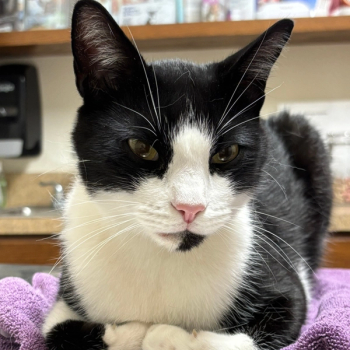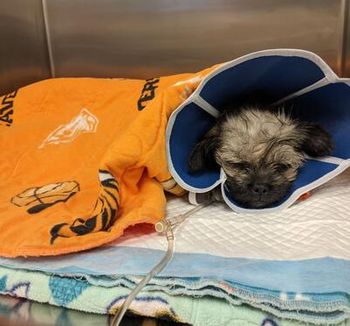
When death comes calling: Top diseases leading to veterinary euthanasia
Here are the most common conditions Lap of Love hospice veterinarians see in their mobile euthanasia practiceand pointers on how to ease clients and patients down this difficult path.
Shutterstock.comPain and death. Death and pain. They often go hand in hand. But for Dani McVety, DVM, and her fellow veterinarians in the
“We as veterinarians are very comfortable with the concept of quality of life,” she told her audience at a recent
A major part of creating that peaceful experience is educating and preparing clients for what to expect as their pet reaches end of life, along with helping them know when euthanasia is an appropriate choice. Here are the top six conditions Lap of Love veterinarians see in association with euthanasia (based on data collected by the company) and how Dr. McVety handles each one with clients.
1. Old age
Obviously old age isn't a disease, “but it sure is a killer,” Dr. McVety says. It's the No. 1 reason Lap of Love clients call to request euthanasia, and what it really means is that the pet's medical condition is undiagnosed. That means anything can happen, so client and doctor alike should brace for the unexpected. Problems with cognition, along with stroke, seizures and organ failure, are all possibilities.
The words you choose
Here are some phrases Dr. McVety uses with her clients when they're facing the possibility of their pet's euthanasia.
If the client says this … “I don't want her to suffer.”
Try this response: “Euthanasia isn't just about stopping suffering that's occurring in the moment but preventing it from occurring at all.”
If the client says this … “I don't know what to do.”
Try this response: “Right now we have the choice to make his passing as peaceful as it can possibly be. If we wait too long, that choice will be taken away.”
If the client says this … “I want her to pass naturally.”
Try this response: “Mother Nature is neither quick nor painless.”
If the client says this … “I want her to go to sleep and not wake back up.”
Try this response: “That's exactly what euthanasia is.”
If the client says this … “I just can't.”
Try this response: “That's OK.” (Note: Detach from the outcome. Once the pressure is off, clients will often call back within an hour or two and be ready.)
If the client says this … “What if it's too soon?”
Try this response: “It's better to help a friend a day too early than a second too late.”
If the client says this … “I don't know what I'm going to do afterward.”
Try this response: “You may not want to hear this right now, but you will feel relief.”
2. Osteoarthritis and mobility issues
This painful disease is the second-most-common reason Dr. McVety receives calls requesting consultation on euthanasia for pets. The pain increases with progression, and clients should be instructed to watch for signs of intensifying discomfort. “Sundowner's syndrome”-awakeness or awareness in the middle of the night, accompanied by panting, pacing, whining and crying-is very common with osteoarthritis (as well as a number of other end-of-life conditions).
While the pet should be on an osteoarthritis treatment protocol, clients may also need rescue drugs to get the pet through a pain crisis before the euthanasia takes place. Dr. McVety says she leaves rescue medications with clients if they're not ready to euthanize yet or if they're trying to make a deadline, such as getting through Christmas or waiting for Mom or Dad to get home to say goodbye.
Along with gabapentin, Dr. McVety uses tramadol for osteoarthritis patients as a rescue drug. “We've learned that tramadol is not necessarily fantastic for pain, but I'll tell you how I use it,” she says. “Tramadol is like a glass of wine-sometimes we need one glass of wine to get through the night; sometimes we need three or four. Of course, if we're using three or four doses multiple nights in a row, we have a quality-of-life issue and we need to have a conversation about that.”
Dr. Dani McVetyAs far as knowing the right time to euthanize, “we have the curse and the luxury of time,” Dr. McVety says. With osteoarthritis patients there is major variation in when a client and veterinarian can make the decision and have it be appropriate and ethical. Sometimes animals will eat through pain and wag their tail right up to the end, so cessation of these activities is not always a reliable indicator, Dr. McVety says. Tell clients this, and let them know it's still OK to say goodbye if pain and anxiety are detracting from the patient's life.
3. Renal failure
With chronic kidney disease, pain is variable depending on the patient: It can range from uncomfortable to very painful. Again, it's best to educate clients on signs of pain and watch for progression in their pets. Rescue drugs can include buprenorphine, tramadol, fluids, anti-emetics and appetite stimulants.
When is it right to euthanize a kidney disease patient? Again, we have the “curse and the luxury of time,” Dr. McVety says. The goal for a high quality of death is to make it a peaceful experience and avoid a crisis that leads to an ER trip.
4. Heart failure
As with chronic kidney disease, pain associated with congestive heart failure (CHF) can range from uncomfortable to sufferable, Dr. McVety says. The main thing she tells her clients to watch for is change, particularly changes in eating. “If a CHF patient comes in and is still eating, we can usually mitigate,” says Dr. McVety, who worked in emergency practice before founding Lap of Love and has seen her share of heart failure. “Not at the very end. If the pet stops eating, that's a huge red flag.”
Rescue drugs for heart failure include high-dose furosemide, and Dr. McVety will even sometimes leave an oxygen machine with the family if they're trying to delay euthanasia until a family member can be present.
When is the right time to euthanize? “Much sooner than you want to if you want a peaceful end-of-life experience,” Dr. McVety tells clients.
5. Hemangiosarcoma
The words you choose
Here are some expressions Dr. McVety suggests eliminating from your euthanasia-related conversations.
Instead of this … “You'll know when it's time.”
Say this: “I realize it's difficult to know when it's the right time. We will work together to know when it's a good time.”
Instead of this … “Call me when you're ready.”
Say this: “Call me when you're ready to talk more about the next step.”
Instead of this … “There's nothing more we can do.”
Say this: “You have done an amazing job.”
Instead of this … “You're making the right decision.”
Say this: “We are making the best decision possible.” (Note: This phrase makes a huge impact on clients-try it and see for yourself.)
Pain associated with hemangiosarcoma, the fifth-most-common condition leading to euthanasia requests, ranges from uncomfortable (in hypoxic patients) to sufferable (discomfort related to pulmonary metastases and pressure from ascites).
Hemangiosarcoma declines rapidly under most conditions in elderly patients. This makes the use of rescue medications (those that act rapidly to mitigate pain) not as applicable in these cases. But they're still useful, if only for their placebo effect with both patient and pet parent, Dr. McVety says. Oxygen may also help certain patients.
A key factor with hemangiosarcoma patients is to educate their owners about what the end will look like-it might be a slow bleed and it might be a fast bleed. “We need to let clients know what to expect so they don't freak out,” Dr. McVety says. “I told one lady about the possibility of a fast bleed, and she said later that because she knew what was happening, her dog died peacefully in her arms and she didn't panic. She gave me a huge hug and a thank you that she knew what to expect.”
With hemangiosarcoma, it's also important to tell clients that euthanasia sooner rather than later is better for a peaceful goodbye experience.
6. Osteosarcoma
Rounding out the top six end-of-life conditions from Dr. McVety, osteosarcoma ranges in painfulness from discomfort to sufferability. Awareness of progression is key for clients, and rescue drugs for controlling pain are very important. The answer to “when should I euthanize?” is, again, “Sooner than you want to,” Dr. McVety says.
Whether it's one of these conditions or any other health problem that makes euthanasia a reasonable choice for client and patient, the bottom line is to let pet owners know what the dying process looks like in their pet's disease context. This helps them stay calm and make good decisions, with your help, about their pet's care. After all, death comes calling for all animals, whether veterinarians step in or not, so everyone involved can release judgment and guilt and focus on the pet-the joy it has brought in life, and the peace and love it can experience with its family at the end.
Newsletter
From exam room tips to practice management insights, get trusted veterinary news delivered straight to your inbox—subscribe to dvm360.





